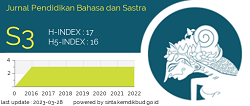Potret Perempuan pada Film Cinderella (2015) dan Cinderella (2021): Sebuah Kajian Sastra Bandingan
Abstract
Cinderella is a well-known literature which tells the story of a girl who suffers from living with her mother and stepsisters, then finds love and happiness by meeting the prince. This romance story filled with magic, loved by various groups, and thanks to its popularity, this story has been adapted several times for the big screen. Each story adaptation certainly has differences. This also applies to the film "Cinderella" which was released in 2015 with the latest "Cinderella" film released in 2021. The biggest difference appears in the aspect of gender, especially regarding how women are portrayed in the two films. After doing a comparison, it was found that the film “Cinderella (2021)” contains many feminist aspects that were not shown in the previous films. Among them is the main character Ella who dares to do business in a social group that looks down on women, as well as the character Gwen, a princess who replaces the prince to become the successor to the royal throne. This, of course influenced by the mindset development of society in the current modern era where gender equality is upheld.
Keywords
Full Text:
PDFReferences
Asmida, E. (2020). Perlawanan Terhadap Dominasi Patriarki Dalam Novel Nyai Gowok Dan Kembang Turi Karya Budi Sardjono: Kajian Feminis Radikal, Jurnal Lakon, 9(2), 71-92.
Bassnett, Su. (1993). Comparative Literature: A Critical Introduction. Oxford: Blackwell Publishers.
Dowling, C. (1992). Tentang Wanita Modern: Ketakutan Wanita Akan Kemandirian. Jakarta: Erlangga.
Endraswara, S. (2003). Metodologi Penelitian Sastra Epistemologi Model Teori dan Aplikasi. Yogyakarta: Pustaka Widyatama.
Hidayatullah, A.D.I.A., & Srimulyani, N.E. (2020). Nilai dari Profesi Ibu Rumah Tangga dalam J-Dorama: Nigeru Wa Haji Da Ga Yaku Ni Tatsu. Kiryoku: Jurnal Studi Kejepangan, 5(2), 209-217.
Humm, M. (1986). Feminist Criticism. Sussex: The Harvester Press Limited.
Manuaba, I.B.P, Setijowati, A., Dewi, T.K.S., Wulandari, R.A., & Karyanto, P.. (1997). Rekontruksi dan Reinterpretasi Perkembangan Pemikiran Wanita: Studi Tentang Teks Novel-Novel Indonesia 1920-1990 dan Perubahan Sosial. Universitas Airlangga.
Ratna, N.K. (2009). Teori, Metode, dan Teknik Penelitian Sastra. Yogyakarta: Pustaka Belajar.
Remak, H. H. (1971). Comparative Literature. In Contemporary Literature: Methods & Perspectives. Illionis: Carbondale & Edwarddsville.
Rollins, J. H. (1996). Women’s Minds Women’s Bodies: The Psychology of Women in a Biosocial Context. United Stated of America: Prentice Hall.
Sugihastuti, & Saptiawan, I.H. (2007). Gender dan Inferioritas Perempuan. Yogyakarta: Pustaka Pelajar.
Suwardi, A. (2010). Feminism as Literary Criticism (Its Development, Figures, and Themes). Jurnal Prosodi IV(2), 1-11.
Yoder, J., & Adams, J. (1984). Women entering nontraditional roles: When work demands and sex-roles conflict. The case of West Point. International Journal of Women’s Studies, 7, 260 –272.
Zuchdi, D. (1993). Panduan Penelitian Analisis Konten. Yogyakarta: Lembaga Penelitian IKIP Yogyakarta.
DOI: https://doi.org/10.17509/bs_jpbsp.v23i1.59877
Refbacks
- There are currently no refbacks.
Copyright (c) 2023 Jurnal Pendidikan Bahasa dan Sastra
p-ISSN 1412-0712 | e-ISSN 2527-8312
JPBS is published by:
Fakultas Pendidikan Bahasa dan Sastra (Faculty of Language and Literature Education), Universitas Pendidikan Indonesia,
in cooperation with
TEFLIN, and APPBIPA


